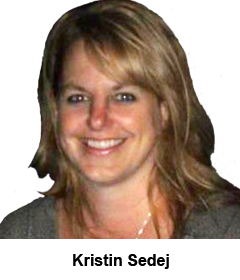Kristin Sedej, principal and owner, brings a strong operational background to S2O Consultants by drawing on her extensive hospitality experience as well as her in-depth knowledge of all facets of the foodservice design industry. She holds a BS in Hospitality Management from Roosevelt University and is a senior associate member of the Foodservice Consultants Society International. Kristin began her career in food service management. After gaining hands-on experience in the industry, she joined Cini-Little International and quickly became known for her personal drive, ability to learn quickly and strong personal skills. She, along with fellow S2O partner Harry Schildkraut, left the company to form Schildkraut, Schroeder, Sedej & Associates in 2003. After that firm was dissolved in 2008, Kristin and Harry formed S2O Consultants and continue to provide a broad range of specialized foodservice consulting services to the sports, healthcare, corporate, education and hospitality industries. Kristin serves the Chicagoland area by providing pro-bono work for the United Methodist Church in Barrington, Ill., the Ronald McDonald House in Chicago and the Salvation Army Recreation Center in Chicago. She enjoys traveling with friends and her two children.


FE&S: How does your experience as a foodservice operator help you be a better design consultant?
Kristin Sedej: I think my job is to serve as the middleman between the operator and the architects and general contractors. That’s because the architects don’t speak foodservice and foodservice operators don’t build things. So my job is to facilitate that communication between the two by designing and writing the specs for a space that meets the operator’s needs. And I draw on my experience as an operator to help with this part of the process.
FE&S: What other steps do you to take to ensure the process is thorough and meets the customer’s needs?
Kristin Sedej: I spend a lot of time in the beginning observing and asking questions, in an effort to understand where they are coming from and the desired goals of the project. It helps me get a better idea of their methodologies, what works and what needs to change. Getting this right in the beginning is the key to producing a successful design.
FE&S: During the course of your 11-year career, how has the role of a consultant changed?
Kristin Sedej: Our competition has changed. Due to the recession, a lot of dealers now include design as a part of their equipment package. As a result, our marketing approach has had to change. Prior to 2008, I thought different consultants were our primary competitors. Now dealers are more involved in design so we have to prove the value of what we as consultants bring to the table and prove the value behind paying our fees.
FE&S: What else has changed about the industry in recent years?
Kristin Sedej: Value and cost matter more than ever before. You have to understand the goal of the project and determine the best value and return for your customer. There is not the same answer that you can use over and over again. You have to look at different ways of doing things and technology has shaped that. Some of the newer consultants have learned that there is no standard formula pretty quickly.
FE&S: Technologies like BIM are starting to impact your world now, aren’t they?
Kristin Sedej: Yes. It is a different way to deliver what we have in our heads. At the end of the day, we still have to build something that solves a problem. BIM is an effort to minimize mistakes and coordinate the project in the best possible way. The projects that differentiate us from the dealers who do design are the big ones and they are all going to BIM, so as consultants we have to hop on board. Plus, if we can get operators to see their space in 3D, we increase the odds of them being happy in the end because they will understand more what they are getting in the beginning.
FE&S: On most large projects, you can have multiple clients, ranging from the architect to the general contractor to the operator. How do you keep it all straight to deliver a good end-product?
Kristin Sedej: Your real client may not be the guy who is writing the check. Most times, it is the architect that hires me but it is the end-user that has to live with the design and equipment spec I write. The architect is concerned with getting the drawings done accurately, fully coordinated with the other team members, on time and on budget. The end user is concerned with how the space functions and the reliability and performance of the equipment. What’s their life going to be like when it’s all said and done? You have to be willing to go back and ask the tough questions. Does it work? Did it solve the problem? Did we meet the goals of the project that we defined in the beginning of the process? That’s where your heart should be.



